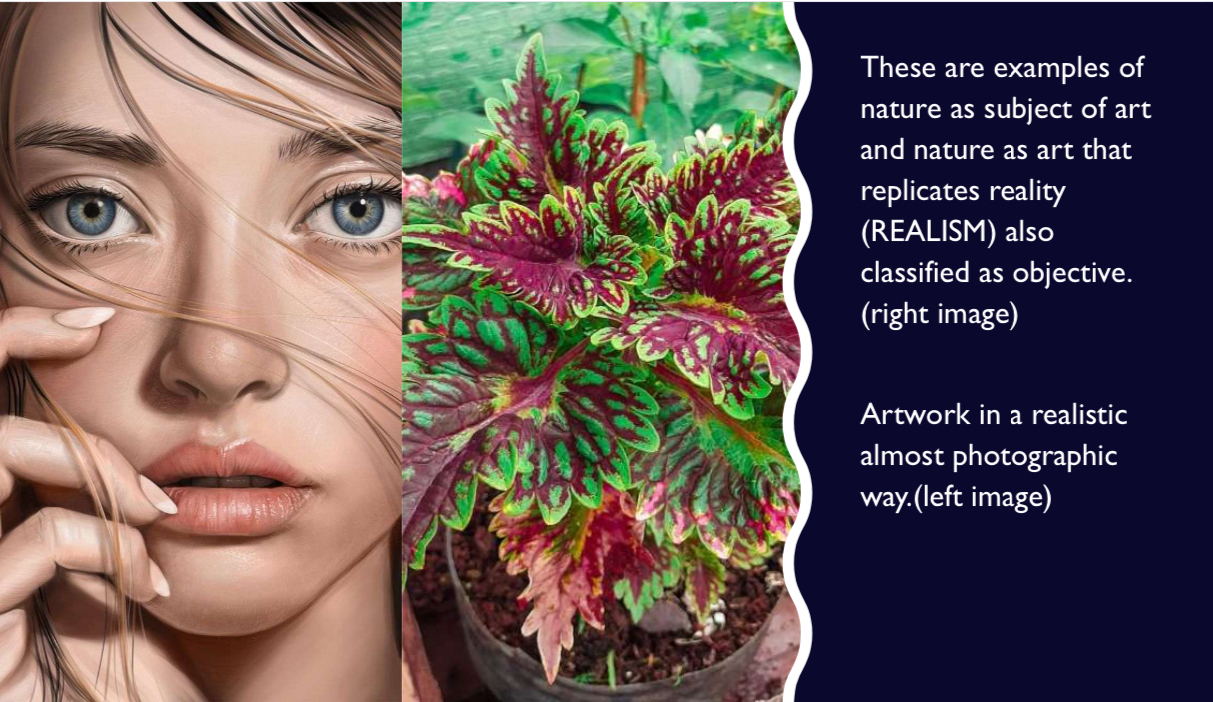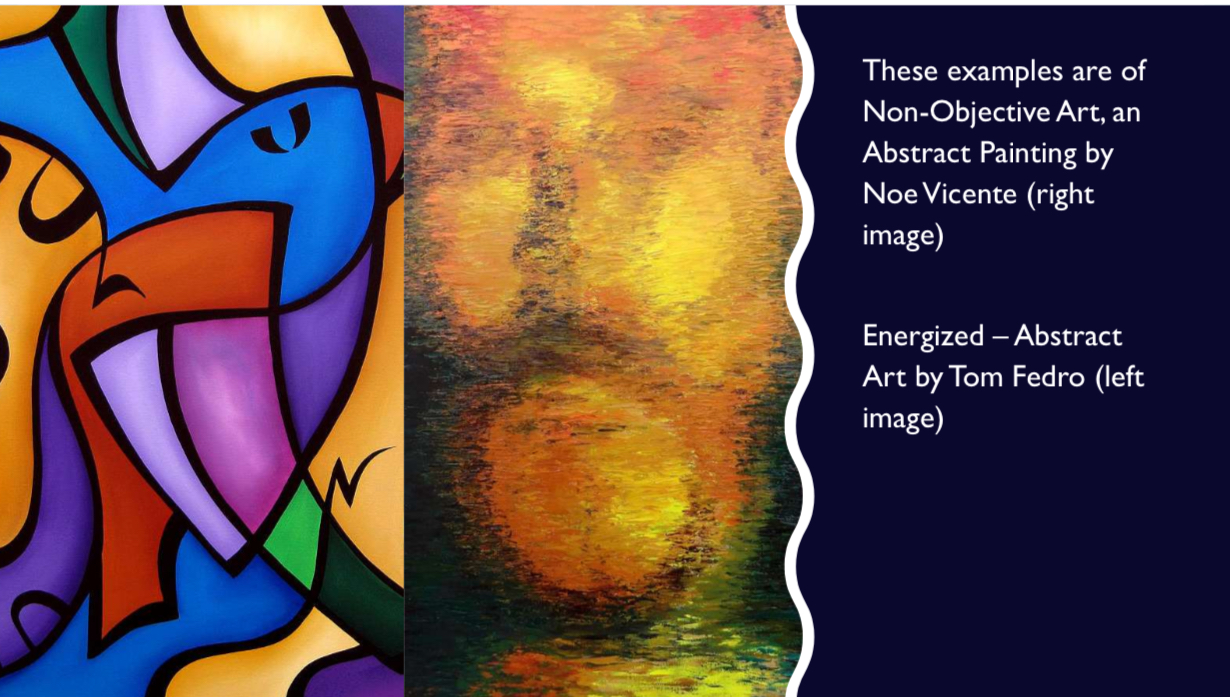ART APPRECIATION #2
1/39
There's no tags or description
Looks like no tags are added yet.
Name | Mastery | Learn | Test | Matching | Spaced |
|---|
No study sessions yet.
40 Terms
FOUR COMMON ESSENTIALS OF ART
Art has to be man made
Art should be creative, not imitative
Art must benefit and satisfy man
Art is expressed through a certain medium
SUBJECT OF ART
The matter to be described or to be portrayed by the artists
Refers to:
Event (everyday life, history, legends)
Dream and Fantasy
Nature
Object
Person
Scene
TWO KINDS OF ART AS TO SUBJECT
Objective Art (Representational)
Nom-Objective (Non-Representational)
OBJECTIVE ART
Representational
Represents description, stories, or references to identifiable objects or symbols
NON-OBJECTIVE ART
Non-Representational
Does not represent any concrete object or symbol
WAYS OF REPRESENTING THE SUBJECT
Realism
Abstraction
Distortion
REALISM
Refers to the movement or style of representing familiar things as they replicates reality
Used to describe artworks painted in realistic photographic way

ABSTRACTION
Refers to art that does not attempt to represent external reality but seeks to achieve its effect using shapes, forms, colors and textures

DISTORTION
Refers to the art of twisting, stretching or deforming the natural shape of the object

ELEMENTS OF ART
Color
Lines
Shapes
Texture
Value
COLOR
Gives quality to the pictorial field and has the ability to elevate sensation of pleasure
Creates mood and symbolizes ideas as well as expression of personal emotion
LINE
Used by the artist to imitate or to represent objects and figure on the flat surface
Depicts the feeling and thoughts of the artist
SHAPES
Used to represent the subjects of the art
The subject can be represented through a natural, abstract and non-objective shape
TEXTURE
Defines the tactile quality of the surface of an object
Expresses a sensuous and decorative quality and creates a spatial depth
VALUE
Depicts the tonal relationship between light and dark areas of painting
MEDIUM OF ART: VISUAL ART
Acrylic
Drawing
Encaustic
Engraving
Etching
Fresco
Intaglio
Mosaic
Painting
Printmaking
Stained Glass
Tempera
Watercolor
ACRYLIC
A medium in painting which uses paints
DRAWING
Refers to the initial or fundamental sketch of painting
ENCAUSTIC
Refers to the application of mixture of hot bee wax, resin and ground pigment to any porous surface followed by heat application
ENGRAVING
Refers to the process of decorating metal artwork with the use of burin
ETCHING
The process of using strong acid or mordant to cut into the unprotected parts of a metal surface to create a design in intaglio in the metal
FRESCO
Refers to the application of earth pigments mixing with water in a plaster wall
INTAGLIO
Refers to scratch, engrave, or etch into metal plate
MOSAIC
Refers to the wall or floor decoration made of small cube or irregular cut pieces of colored stone or glass
PAINTING
Refers to the process of applying pigment (colors) on the smooth surface (paper, cloth, canvas, wood, plaster)
PRINTMAKING
Refers to the graphic image that results from duplicating process
STAINED GLASS
Refers to window decoration made of irregular cut pieces of colored glass
TEMPERA
Refers to the application of a mixture of egg yolk and white and earth and mineral pigment
WATERCOLOR
A versatile medium that involves using pigments mixed with water
PRINCIPLES OF DESIGN
Balance
Emphasis and subordination
Harmony
Proportion
Rhythm
Variation
BALANCE
The gravitational equilibrium in visual arts which depicts the feeling of equality in weight, attention of the various elements
SYMMETRICAL (Formal Balance)
Identical or similar to the other (mirrored)
Can be used to create a feeling of order, stability, calmness and serenity within art composition
RADIAL BALANCE
Elements of artwork are arranged in a circular pattern around a central point
Used to create a feeling of order and harmony
ASYMMETRICAL (Occult or Felt Balance)
No formal balance on either side of the artwork but the subjects are place in parallel position
Can be used to create a feeling of vibrancy and movement
CRYSTALLOGRAPHIC BALANCE
Or mosaic balance (less common)
Has equal weight given to many art elements at once but they aren’t in a perfectly symmetrical pattern
Finds harmony in repetition
Also called as an all-over balance
EMPHASIS AND SUBORDINATION
Reflects between the more important and less important in artworks
Concerned in stressing the proper important to the parts and to the whole of artworks
HARMONY
All parts of visual image are related and complement with each other
There is an agreement between the parts of a composition which result in unity
PROPORTION
Means the ratio of the part to another and of the whole that can be expressed in size, number and position
A comparative harmonious relationship between two or more elements in a composition with respect to size, color, quantity, degree, setting, etc.
RHYTHM
Means repetition or continuance flow of regular visual units
Refers to the movement achieve through the repetition of the regular visual unit
VARIATION
Means elements and subjects of artworks contrast with or slightly different from others which prevent monotony or uniformity